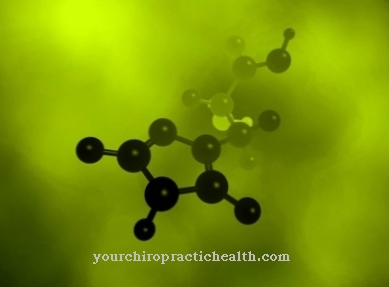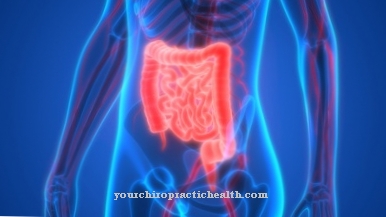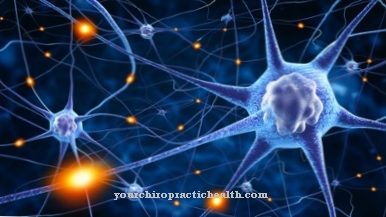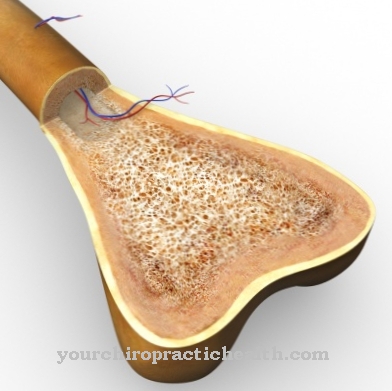The osmosis is a directed flow of molecular particles through a semipermeable membrane. In biology it is of central importance for regulating the water balance in the cells.
What is osmosis?

Osmosis means "penetration" in Greek. It is described as the spontaneous passage of solvents such as water through a selectively permeable membrane. The membrane is only permeable to the solvent, but not to the dissolved substances. Due to the selective diffusion of only one component, the chemical potential is balanced on both sides of the membrane.
Osmosis is often found in nature. In biological membranes in particular, a selective exchange of substances is necessary so that biological transport processes can take place. However, active, energy-consuming transport processes also ensure that the passively arising osmotic pressure does not have a destructive effect on the cell.
While no reversal is possible with normal diffusion processes, osmosis is a reversible process.
Function & task
In osmosis, molecules of a solution or a pure solvent diffuse selectively through a membrane until the chemical potential is balanced on both sides of this membrane. For example, a concentrated solution on the other side is diluted by the solvent until the built-up hydrostatic pressure prevents further diffusion.
The molecules can migrate through the membrane, regardless of which side they come from. However, they are always more likely to diffuse in the direction of the greatest potential difference.
When the chemical potential is balanced, the same number of particles migrate from left to right as from right to left. So externally nothing changes anymore. However, as a result of the desired dilution of the concentrated solution, a higher amount of liquid has accumulated on the one hand, which has built up a high pressure (the osmotic pressure). If the membrane can no longer withstand the pressure, the cell can be destroyed.
Active transport processes through the membrane ensure that certain substances are removed with the use of energy. A vivid example of an osmotic process is the swelling of ripe cherries when they are mixed with water. The water penetrates through the outer skin of the fruit, while the sugar cannot escape. The dilution process within the fruit continues until it bursts.
Within the body, the combination of osmotic and active, energy-consuming transport processes ensures that biochemical processes run smoothly in spaces separated by biomembranes. Cells can exist that separate from the external environment, but are in constant exchange of substances with it.
Organelles are also present within the cell where separate reactions can take place. To prevent the osmotic pressure from increasing to such an extent that the biomembranes burst open, molecules are discharged through active transport processes.
In mammalian cells, when the osmotic pressure increases, the protein NFAT5 is produced to a greater extent. It provides a number of counter-mechanisms to protect the cell from hypertonic stress (excess pressure). In the process, transport proteins are produced which, using energy, channel certain substances out of the cell. Among other things, urinary substances such as glucose and excess electrolytes are excreted through the kidneys in order to regulate the osmotic pressure in the body.
Illnesses & ailments
Osmosis also plays an important role in regulating the electrolyte balance. Electrolytes are dissolved salts and consist of positively charged metal ions such as sodium, potassium, magnesium or calcium ions and negatively charged anions such as chloride, bicarbonate or phosphate anions.
They are present in different concentrations both in the cell (intracellular), outside the cells (interstitial) or within the bloodstream (intravascular). The differences in concentration generate the electrical voltage on the cell membranes and thus trigger a multitude of processes at the cell level. If the concentration differences are disturbed, the entire electrolyte balance is also mixed up.
The kidneys regulate this electrolyte balance through various mechanisms such as thirst mechanisms, hormonal processes or peptides that act on the kidneys. With severe diarrhea, vomiting, blood loss or kidney failure, the water and electrolyte balance can be disturbed. Each electrolyte can occur in concentrations that are either too high or too low.
Disturbances in the water and electrolyte balance are sometimes life-threatening, depending on their severity. Examples of such conditions include dehydration, hyperhydration, hyper- and hypovolemia (blood volume is increased or decreased), hypo- and hypernatremia, hypo- and hyperkalaemia or else hypo- and hypercalcemia.
Each of these conditions requires intensive treatment. Usually the water and electrolyte balance quickly equilibrates. However, if the regulating mechanism between active transport processes and osmotic processes is disturbed by renal insufficiency or another disease, chronic electrolyte imbalances can occur. As a result, edema, cardiovascular diseases, brain edema, states of confusion or seizures occur.
The relationships between the water and electrolyte balance and the biological processes in the body are so complex that similar symptoms are often observed for all forms of electrolyte disorders. The determination of the electrolyte balance should be part of the standard examinations if these symptoms are chronic.













.jpg)

.jpg)
.jpg)











.jpg)